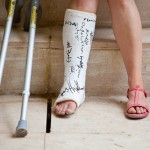
While most people would likely associate tricyclic antidepressants (TCAs) with more common adverse effects such as dry mouth, sedation and constipation, there is some evidence to suggest increased occurrence of bone fractures (Vestergaard, Rejnmark, & Mosekilde, 2006). However, the topic remains controversial and conflicting results about the association of TCAs and fracture risk abound (e.g. Ensrud et al., 2003).
Methods
In order to provide clinicians with a clearer picture of costs and benefits of TCA treatment, Wu et al. (2013) set about to aggregate relevant studies in a single meta-analysis that takes all relevant moderators into consideration. In total, 12 publications met inclusion criteria, including five cohort and seven case-control studies.
Results
-

This study combined the findings of 5 cohort and 7 case-control studies
Patients currently treated with TCAs (compared with patients who had taken no TCAs) had a 45% higher relative risk of bone fracture (RR = 1.45, 95% CI = 1.31-1.60)
- Statistical correction for publication bias slightly lowered the relative risk (RR = 1.36, 95% CI = 1.24-1.50), which remained clinically significant
- On the other hand, analysis based solely on the ten studies that controlled for major confounders (e.g. age or comorbidities) barely deflated the relative risk (1.42)
- Other statistical tweaks had minimal effects on RR, suggesting the pooled estimate is a robust indicator
- Several factors suggest TCAs increase relative risk because they lead to higher propensity for falling and not because of their effects on the skeleton itself
Conclusion
This meta-analysis substantiates earlier claims that TCA antidepressant treatment is associated with higher occurrences of bone fractures, largely irrespective of moderating factors.
Limitations

This study does not prove that taking tricyclic antidepressants causes bone fractures, but rather that there is a clear association
Because relative risks provide associative as opposed to causative information, it is impossible to claim TCAs directly lead to more fractures.
Likewise, the number of primary studies is very small and often heterogeneous, to say the least. This is especially cumbersome as most studies lack information on patients’ medical history and treatments that could affect bone composition, including some immunosuppressants or anti-seizure medication.
As TCAs seem to mostly increase risk of fracture by affecting postural stability, more information on previous falls etc. is necessary to arrive at more definite conclusions. Sadly, though, this information is rarely provided.
Summary

This study is especially relevant to older people who take tricyclic antidepressants, as they are already at higher risk of falls
Wu et al. suggest usage of TCAs is associated with an increased relative risk of fractures compared to non-TCA treatment in the context of mood disorders, irrespective of bone characteristics.
Even though TCAs have largely been supplanted by safer drugs, such warnings should still be taken seriously, especially in already vulnerable populations, such as the elderly. As TCAs’ additional risks are most likely mediated by influences on circulation and blood pressure, drugs with similar cardiovascular side effects (e.g. atypical antipsychotics) should also be prescribed with care.
Interestingly, there is evidence to suggest selective serotonin reuptake-inhibitors, arguably the most often employed antidepressants of today, are also linked with increased fracture risk (Wu et al., 2012). Why this is the case even though sedation or low blood pressure are seldom reported experiences remains to be determined by future studies.
In any case, this meta-analysis highlights the importance of not just considering the diagnosis, but the human who bears it and their situation.
Links
Wu, Q., Qu, W., Crowell, M.D., Hentz, J.G., & Frey, K.A. (2013). Tricyclic antidepressant use and risk of fractures: meta-analysis of cohort and case-control studies. J Bone Min Res, 28(4), 753-763. [PubMed abstract]
Vestergaard, P., Rejnmark, L., & Mosekilde, L. (2006). Anxiolytics, sedatives, antidepressants, neuroleptics and the risk of fracture. Osteoporos Int, 17(6), 807–16. [PubMed abstract]
Ensrud, K.E., Blackwell, T., Mangione, C.M., Bowman, P.J., Bauer, D.C., Schwartz, A., Hanlon, J.T., Nevitt, M.C., Whooley, M.A. (2003). Study of Osteoporotic Fractures Research Group. Central nervous system active medications and risk for fractures in older women. Arch Intern Med, 163(8), 949–57. [PubMed abstract]
Wu, Q., Bencaz, A.F., Hentz, J.G., & Crowell, M.D. (2012). Selective serotonin reuptake inhibitor treatment and risk of fractures: a meta-analysis of cohort and case-control studies. Osteoporos Int, 23(1), 365–75. [PubMed abstract]


Tricyclic antidepressants are associated with higher risk of bone fracture: While most people would likely ass… http://t.co/gxbDGtBMFy
@Mental_Elf so if SSRIs also have incr # risk what antidepressant best for osteoporosis?
New meta-analysis of cohort & case-control studies investigates the links between antidepressant use & bone fractures http://t.co/vzsJYPPsay
“@Mental_Elf: analysis of links between ADM & bone fractures http://t.co/IfFTbizBRo” patients should be informed of side effects and options
In case you missed it earlier: Tricyclic antidepressants are associated with higher risk of bone fracture http://t.co/vzsJYPPsay
@Mental_Elf Not much help if you don’t know which ones are TC and which ones aren’t.
@Mental_Elf why?
@karlscheeres @Mental_Elf risk of falls
@PsychiatrySHO @Mental_Elf makes sense
Mental Elf: Tricyclic antidepressants are associated with higher risk of bone fracture http://t.co/oIHHafDsGL
New from @Mental_Elf #Tricyclic antidepressants are associated with higher risk of bone fracture http://t.co/jzZWMIa4ZV
[…] Tricyclic antidepressants are associated with higher risk of bone fracture […]